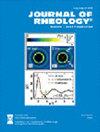Rheology of non-Brownian particle suspensions in viscoelastic solutions. Part II: Effect of a shear thinning suspending fluid
IF 3.2
2区 工程技术
Q2 MECHANICS
引用次数: 2
Abstract
The shear rheology of particle suspensions in shear-thinning polymeric fluids is studied experimentally using parallel plate measurements and numerically using fully resolved, 3D finite volume simulations with the Giesekus fluid model. We show in our experiments that the steady shear viscosity and first normal stress difference coefficient of the suspension evolve from shear-thickening to substantially shear-thinning as the degree of shear-thinning of the suspending fluid increases. Moreover, in highly shear-thinning fluids, the suspension exhibits greater shear-thinning of the viscosity than the suspending fluid itself. Our dilute body-fitted simulations show that in the absence of hydrodynamic interactions, shear-thinning can arise from the particle-induced fluid stress (PIFS), which ceases to grow with increasing shear rate at low values of [Formula: see text] (solvent viscosity ratio) and finite values of [Formula: see text] (the Giesekus drag coefficient). In a Giesekus suspending fluid, the polymers surrounding the suspended particle are unable to stretch sufficiently at high Weissenberg numbers (Wi) and the reduced polymer stress results in a lower PIFS. When coupled with the shear-thinning stresslet, this effect creates an overall shear-thinning of the viscosity. We then explore the effects of particle-particle interactions on the suspension rheology using immersed boundary simulations. We show that multiparticle simulations are necessary to obtain the shear-thinning behavior of the per-particle viscosity of suspensions in shear-thinning fluids at moderate values of [Formula: see text]. Particle-particle interactions lead to a substantial decrease in the PIFS and an enhancement of the shear-thinning of the stresslet compared to the single particle simulations. This combination leads to the shear-thinning of the per-particle viscosity seen in experiments. We also find that very low values of [Formula: see text] and finite values of [Formula: see text] have opposing effects on the per-particle viscosity that can lead to a nonmonotonic per-particle viscosity versus shear rate in a highly shear-thinning fluid. Overall, the addition of rigid particles to highly shear-thinning fluids, such as joint synovial fluid, leads to increased viscosity and also increased shear-thinning at high shear rates.粘弹性溶液中非布朗粒子悬浮液的流变学。第二部分:剪切稀化悬浮液的影响
使用平行板测量和Giesekus流体模型的全分辨率三维有限体积模拟,对剪切稀化聚合物流体中颗粒悬浮液的剪切流变性进行了实验研究。我们在实验中表明,随着悬浮液剪切减薄程度的增加,悬浮液的稳定剪切粘度和第一法向应力差系数从剪切增稠演变为基本剪切减薄。此外,在高剪切稀化流体中,悬浮液表现出比悬浮液本身更大的粘度剪切稀化。我们的稀释体拟合模拟表明,在没有流体动力学相互作用的情况下,颗粒诱导的流体应力(PIFS)可能会导致剪切变薄,在[公式:见正文](溶剂粘度比)的低值和[公式:看正文](Giesekus阻力系数)的有限值下,PIFS会随着剪切速率的增加而停止增长。在Giesekus悬浮液中,悬浮颗粒周围的聚合物在高Weissenberg数(Wi)下不能充分拉伸,并且降低的聚合物应力导致较低的PIFS。当与剪切减薄应力相结合时,这种效应会产生粘度的整体剪切减薄。然后,我们使用浸没边界模拟来探索颗粒-颗粒相互作用对悬浮流变学的影响。我们表明,在[公式:见正文]的中等值下,多粒子模拟对于获得剪切稀化流体中悬浮液的每粒子粘度的剪切稀化行为是必要的。与单粒子模拟相比,粒子-粒子相互作用导致PIFS显著降低,并增强了小应力的剪切减薄。这种组合导致实验中看到的每颗粒粘度的剪切变薄。我们还发现,[公式:见正文]的非常低的值和[公式:看正文]的有限值对每颗粒粘度具有相反的影响,这可能导致在高剪切稀化流体中每颗粒粘度相对于剪切速率的非单调性。总的来说,在高剪切减薄液(如关节滑液)中添加刚性颗粒会导致粘度增加,并在高剪切速率下增加剪切减薄。
本文章由计算机程序翻译,如有差异,请以英文原文为准。
求助全文
约1分钟内获得全文
求助全文
来源期刊

Journal of Rheology
物理-力学
CiteScore
6.60
自引率
12.10%
发文量
100
审稿时长
1 months
期刊介绍:
The Journal of Rheology, formerly the Transactions of The Society of Rheology, is published six times per year by The Society of Rheology, a member society of the American Institute of Physics, through AIP Publishing. It provides in-depth interdisciplinary coverage of theoretical and experimental issues drawn from industry and academia. The Journal of Rheology is published for professionals and students in chemistry, physics, engineering, material science, and mathematics.
 求助内容:
求助内容: 应助结果提醒方式:
应助结果提醒方式:


